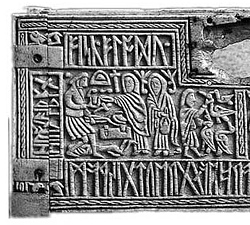|
Eihwaz
Eiwaz or Eihaz is the reconstructed Proto-Germanic name of the rune , coming from a word for "yew". Two variants of the word are reconstructed for Proto-Germanic, ''*īhaz'' (''*ē2haz'', from Proto-Indo-European '), continued in Old English as (also ), and ''*īwaz'' (''*ē2waz'', from Proto-Indo-European '), continued in Old English as ''īw'' (whence English '). The latter is possibly an early loan from the Celtic, compare Gaulish ''ivos'', Breton ''ivin'', Welsh ''ywen'', Old Irish '' ēo''. The common spelling of the rune's name, "Eihwaz", combines the two variants; strictly based on the Old English evidence, a spelling "Eihaz" would be more proper. Following the convention of Wolfgang Krause, the rune's standard transliteration today is ''ï'', though this designation is somewhat arbitrary as the rune's purpose and origin is still not well understood. Elmer Antonsen and Leo Connolly theorized that the rune originally stood for a Proto-Germanic vowel lost by the time of t ... [...More Info...] [...Related Items...] OR: [Wikipedia] [Google] [Baidu] |
Taxus Baccata
''Taxus baccata'' is a species of evergreen tree in the family Family (from la, familia) is a group of people related either by consanguinity (by recognized birth) or affinity (by marriage or other relationship). The purpose of the family is to maintain the well-being of its members and of society. Idea ... Taxaceae, native to western, central and southern Europe (including Britain and Ireland), northwest Africa, northern Iran, and southwest Asia.Rushforth, K. (1999). ''Trees of Britain and Europe''. Collins . It is the tree originally known as yew, though with other related trees becoming known, it may now be known as common yew, English yew, or European yew. It is primarily grown as an ornamental. Most parts of the plant are poisonous, with toxins that can be absorbed through inhalation and through the skin; consumption of even a small amount of the foliage can result in death. Taxonomy and naming The word ''yew'' is from Proto-Germanic language, Proto-Germanic ''*īwa- ... [...More Info...] [...Related Items...] OR: [Wikipedia] [Google] [Baidu] |
Proto-Germanic Language
Proto-Germanic (abbreviated PGmc; also called Common Germanic) is the reconstructed proto-language of the Germanic branch of the Indo-European languages. Proto-Germanic eventually developed from pre-Proto-Germanic into three Germanic branches during the fifth century BC to fifth century AD: West Germanic, East Germanic and North Germanic, which however remained in contact over a considerable time, especially the Ingvaeonic languages (including English), which arose from West Germanic dialects and remained in continued contact with North Germanic. A defining feature of Proto-Germanic is the completion of the process described by Grimm's law, a set of sound changes that occurred between its status as a dialect of Proto-Indo-European and its gradual divergence into a separate language. As it is probable that the development of this sound shift spanned a considerable time (several centuries), Proto-Germanic cannot adequately be reconstructed as a simple node in a tree ... [...More Info...] [...Related Items...] OR: [Wikipedia] [Google] [Baidu] |
Anglo-Saxon Runes
Anglo-Saxon runes ( ang, rūna ᚱᚢᚾᚪ) are runes used by the early Anglo-Saxons as an alphabet in their writing system. The characters are known collectively as the futhorc (ᚠᚢᚦᚩᚱᚳ ''fuþorc'') from the Old English sound values of the first six runes. The futhorc was a development from the 24-character Elder Futhark. Since the futhorc runes are thought to have first been used in Frisia before the Anglo-Saxon settlement of Britain, they have also been called Anglo-Frisian runes. They were likely to have been used from the 5th century onward, recording Old English and Old Frisian. They were gradually supplanted in Anglo-Saxon England by the Old English Latin alphabet introduced by Irish missionaries. Futhorc runes were no longer in common use by the eleventh century, but The Byrhtferth's Manuscript (MS Oxford St John's College 17) indicates that fairly accurate understanding of them persisted into at least the twelfth century. History There are competin ... [...More Info...] [...Related Items...] OR: [Wikipedia] [Google] [Baidu] |

